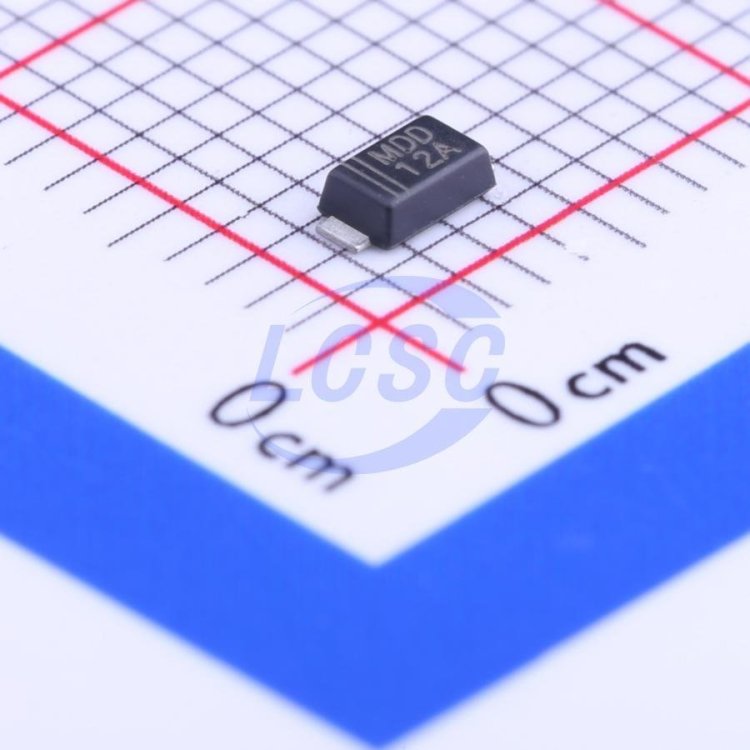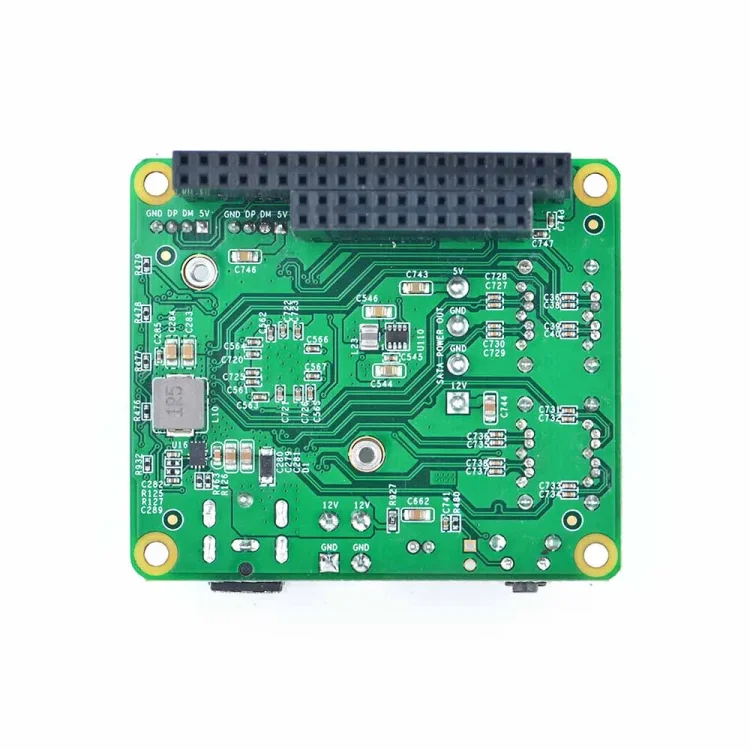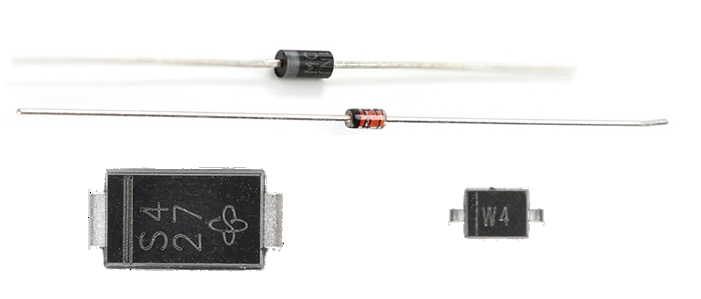
evilm
-
Posts
9 -
Joined
-
Last visited
Content Type
Forums
Store
Crowdfunding
Applications
Events
Raffles
Community Map
Posts posted by evilm
-
-
I'll take a look upon this tomorrow. For the diode, the side with stripes is the cathode.
By the looks on the photo, it doesn't seems that the other component (the one with 12 pins) is damaged. It looked bad on the first photo you attached to the post. Although I cannot say for sure, it may be damaged, even if it doesn't show any external markings or signs of damage.
In many cases damages like this one, that happened by over voltage, end up in something like just a shorted diode, it all depends on the board design and components used.
You can replace this smd diode with any other that has at least the same specification.I'll take a look on this diode code tomorrow, there are references for 12A smd common diodes and zener diodes. Although if it was an zener diode it probably would be marked as DZ1 or Z1 on the board. It also could be a TVS diode (suppressor diode), these types are used to protect sensitive components against transients and voltage spikes.
By the photos, It looks like the diode code is not MOD 12A. I cannot identify the last letter on the first line, the first one is an M and middle one looks like a D. Maybe it says MDD? On the second line I can see clearly the number 12 but cannot identify the last character. Maybe the code is MDD 12A or MDO 12A?
You could remove this diode and test to see if there are any shorts between the 12V, 5v and GND rails. Do you have a multimeter?
If it is a TVS protection diode, you could remove it, and test if there are any shorts left on the board. If no more shorts could be found the board may work without the diode for testing purposes. Is extremely advisable to find a suitable replacement. You need to make sure that there are no shorts on the board if you intend to test it. If there are any shorts on the board and you plug it you could damage the power supply, the orange pi or the sata hdd/ssd.
The diode could be the following:
TVS diode: SMF12A (there are pictures of diodes from this manufacturer with the marking MDD - microdiode electronics)
There are other diodes from mdd but since yours seems to be marked as 12A, I guess this one should be the model you are looking for.
https://www.lcsc.com/product-detail/TVS_Jiangsu-Yutai-Elec-SMF12A_C123800.html
https://datasheet.lcsc.com/lcsc/2401290930_MDD-Microdiode-Electronics--SMF12A_C123800.pdf
As I stated earlier, you could replace this diode with any other that has similar specification.
TVS diode: P6SMB12A (from littelfuse)
This manufacturer also has a 12A diode that has close enough specification.
TVS diode: SM15T12A (from sgs-thomson)
This manufacturer also has a 12A diode that has close enough specification.
http://elektronikjk.pl/elementy_czynne/diody/SM15T6V8C.pdf
-
This component in the circled area is a diode. It is possible to confirm it by the silkscreen on the board, it is labeled as D1(Diode 1).
The other components up on the silkscreen, C281, C279 and C280 are the three smd ceramic capacitors above the diode.
The diode looks damaged, but the photo is too dark to confirm it. You could clean it a bit and try to read the code of this diode.Another way to get this information is by searching the schematic, if available, for this board and look what diode is D1.
Also you should check the component U16, it looks damaged, but again cannot say for sure, the photo is too dark.
I guess this board provides 12VDC and 5VDC for the sata drives. Maybe the U16 is the regulator responsible for the 5 volts, cannot say for sure as I don't have this board or it's schematics.
You could replace the damaged components, it may be an easy fix if nothing else is shorted. You should also check if nothing else is defective, don't know if you are experienced with repairing electronics.
If I found the schematics for this board I'll post it here.
Can you read the code on the diode?
And about the orienting of the diode, I guess, by the looks of it in this photo, that the cathode side is towards the silkscreen that says 12V.In diodes, the side with the stripe marking is the cathode and the other side is the anode.
-
15 hours ago, evilm said:
I'm suspecting that this issue I'm facing is power related. When I get back home I'll do some testing and let you guys know about.
Thank you for the help.Hello guys, firstly I want to apologize for creating a big post without taking proper care of my setup, I guess it was a power related issue at all. I`ve managed to boot all the images (current stables, and developers one).
I`m posting this from the Orange Pi Win Plus with the current desktop stable image (Armbian_5.41_Orangepiwin_Ubuntu_xenial_default_3.10.107_desktop.img) and it`s working great. I`ll do more testings and share my finds with you.
I`ll use the server version, but wanted to try the desktop image.
My problem was inside the power jack plug, it was someway loose inside and thus not offering proper contact with the central pin of jack (plus) off the board. The connection between the plug and the board was pretty fit so I didn`t thought that this would be the origin of my issue. I discovered this because I decided to power the board using some testing logic clamps I have laying around instead of the plug itself and then the board booted flawlessly with all the images and with all micro sd cards I have.
I thought the problem would be a bad solder joint on the plug itself, but in fact it was a problem inside the jack`s barrel. I crack it open to see what was going on and the metal connection inside the barrel was broken and barely making contact, it was only "working" because when I plugged it onto the board the pressure between the metal parts and the central pin of the board provided some contact.
Thank you guys for the responses.
-
I'm suspecting that this issue I'm facing is power related. When I get back home I'll do some testing and let you guys know about.
Thank you for the help. -
23 hours ago, Igor said:
Support for A64 boards is not the best but not this bad. Most of the images from the download sections have been tested. I can't double check ATM but I am almost sure the problem is not on our side.Boot bootlogs indicates troubles related to boot media. I would choose some other SD card brand, double check powering, ... https://forum.armbian.com/forum/31-sd-card-and-power-supply/
Just tried the Armbian_5.41_Orangepiwin_Ubuntu_xenial_default_3.10.107_desktop.img with a brand new Sandisk Ultra 32gb micro sd and got the same console output as reported earlier in this post. Here is my log:HELLO! BOOT0 is starting! boot0 commit : 045061a8bb2580cb3fa02e301f52a015040c158f boot0 version : 4.0.0 set pll start set pll end rtc[0] value = 0x00000000 rtc[1] value = 0x00000000 rtc[2] value = 0x00000000 rtc[3] value = 0x00000000 rtc[4] value = 0x00000000 rtc[5] value = 0x00000000 DRAM driver version: V1.1 rsb_send_initseq: rsb clk 400Khz -> 3Mhz PMU: AXP81X ddr voltage = 1500 mv DRAM Type = 3 (2:DDR2,3:DDR3,6:LPDDR2,7:LPDDR3) DRAM clk = 672 MHz DRAM zq value: 003b3bbb DRAM single rank full DQ OK DRAM size = 2048 MB DRAM init ok dram size =2048 card boot number = 0, boot0 copy = 0 card no is 0 sdcard 0 line count 4 [mmc]: mmc driver ver 2015-05-08 20:06 [mmc]: sdc0 spd mode error, 2 [mmc]: Wrong media type 0x00000000 [mmc]: ***Try SD card 0*** [mmc]: HSSDR52/SDR25 4 bit [mmc]: 50000000 Hz [mmc]: 30436 MB [mmc]: ***SD/MMC 0 init OK!!!*** sdcard 0 init ok The size of uboot is 000e8000. sum=edd51168 src_sum=edd51168 Succeed in loading uboot from sdmmc flash. boot0: start load other image boot0: Loading BL3-1 Loading file 0 at address 0x40000000,size 0x0000a200 success boot0: Loading scp Loading file 2 at address 0x00040000,size 0x00019a00 success set arisc reset to de-assert state Ready to disable icache. ▒▒▒▒ɽ▒▒▒▒5R▒NOTICE: BL3-1: v1.0(debug):3cdc5c3 NOTICE: BL3-1: Built : 13:03:37, Jan 10 2018 INFO: BL3-1: Initializing runtime services INFO: BL3-1: Preparing for EL3 exit to normal world INFO: BL3-1: Next image address = 0x4a000000 INFO: BL3-1: Next image spsr = 0x1d3 U-Boot 2014.07 (Feb 11 2018 - 19:21:28) Allwinner Technology uboot commit : 6f37e5cf6a65b0b10455d12dbd631effabe765ec rsb: secure monitor exist [ 0.368]pmbus: ready [ 0.370][ARISC] :arisc initialize [ 0.700][ARISC] :arisc_dvfs_cfg_vf_table: support only one vf_table [SCP] :sunxi-arisc driver begin startup 2 [SCP] :arisc_para size:1a8 [SCP] :arisc version: [v0.1.76] [SCP] :sunxi-arisc driver v1.10 is starting [ 0.827][ARISC] :sunxi-arisc driver startup succeeded [ 0.861]PMU: AXP81X [ 0.863]PMU: AXP81X found bat_vol=258, ratio=100 [ 0.869]PMU: dcdc2 1100 [ 0.872]PMU: cpux 1008 Mhz,AXI=336 Mhz PLL6=600 Mhz,AHB1=200 Mhz, APB1=100Mhz AHB2=300Mhz MBus=400Mhz device_type = 3253, onoff=1 dcdc1_vol = 3300, onoff=1 dcdc2_vol = 1100, onoff=1 dcdc6_vol = 1100, onoff=1 aldo1_vol = 2800, onoff=0 aldo2_vol = 1800, onoff=1 aldo3_vol = 3000, onoff=1 dldo1_vol = 3300, onoff=0 dldo2_vol = 3300, onoff=0 dldo3_vol = 2800, onoff=0 dldo4_vol = 3300, onoff=1 eldo1_vol = 1800, onoff=1 eldo2_vol = 1800, onoff=0 eldo3_vol = 1800, onoff=0 fldo1_vol = 1200, onoff=0 fldo2_vol = 1100, onoff=1 gpio0_vol = 3100, onoff=0 vbus not exist no battery, limit to dc run key detect no key found no uart input DRAM: 2 GiB fdt addr: 0xb6ebce80 Relocation Offset is: 75f0f000 In: serial Out: serial Err: serial gic: sec monitor mode [ 1.683]start drv_disp_init init_clocks: finish init_clocks. enable power vcc-hdmi-33, ret=0 drv_disp_init finish boot_disp.output_disp=0 boot_disp.output_type=3 boot_disp.output_mode=10 fetch script data boot_disp.auto_hpd fail disp0 device type(4) enable attched ok, mgr0<-->device1, type=4, mode=10 [ 2.052]end workmode = 0,storage type = 1 [ 2.056]MMC: 0 [mmc]: mmc driver ver 2015-06-03 13:50:00 SUNXI SD/MMC: 0 [mmc]: start mmc_calibrate_delay_unit, don't access device... [mmc]: delay chain cal done, sample: 192(ps) [mmc]: media type 0x0 [mmc]: Wrong media type 0x0 [mmc]: ************Try SD card 0************ [mmc]: host caps: 0x27 [mmc]: MID 03 PSN 212062df [mmc]: PNM SU32G -- 0x53-55-33-32-47 [mmc]: PRV 8.0 [mmc]: MDT m-9 y-2013 [mmc]: speed mode : HSSDR52/SDR25 [mmc]: clock : 50000000 Hz [mmc]: bus_width : 4 bit [mmc]: user capacity : 30436 MB [mmc]: ************SD/MMC 0 init OK!!!************ [mmc]: erase_grp_size : 0x1WrBlk*0x200=0x200 Byte [mmc]: secure_feature : 0x0 [mmc]: secure_removal_type : 0x0 [ 2.246]sunxi flash init ok ** Unable to use mmc 0:1 for loading the env ** Using default environment --------fastboot partitions-------- mbr not exist base bootcmd=run mmcbootcmd bootcmd set setargs_mmc key 0 recovery key high 12, low 10 fastboot key high 6, low 4 no misc partition is found to be run cmd=run mmcbootcmd update dtb dram start update dtb dram end serial is: 64107884c8080c2e060f check for ANX9807 get Pine64 model from DRAM size DRAM >512M Pine64 model: pine64-plus no battery exist sunxi bmp: unable to open file /boot/bootlogo.bmp [ 2.528]inter uboot shell autoboot in 3 seconds, Press s or <Esc><Esc> to abort 4984 bytes read in 24 ms (202.1 KiB/s) Booting with script ... ## Executing script at 41000000 166 bytes read in 18 ms (8.8 KiB/s) 69613 bytes read in 33 ms (2 MiB/s) 4353898 bytes read in 259 ms (16 MiB/s) 12636952 bytes read in 676 ms (17.8 MiB/s) Image lacks image_size field, assuming 16MiB ## Loading init Ramdisk from Legacy Image at 45300000 ... Image Name: uInitrd Image Type: ARM Linux RAMDisk Image (gzip compressed) Data Size: 4353834 Bytes = 4.2 MiB Load Address: 00000000 Entry Point: 00000000 Verifying Checksum ... OK ## Flattened Device Tree blob at 45000000 Booting using the fdt blob at 0x45000000 reserving fdt memory region: addr=41010000 size=10000 reserving fdt memory region: addr=41020000 size=800 reserving fdt memory region: addr=40100000 size=4000 reserving fdt memory region: addr=40104000 size=1000 reserving fdt memory region: addr=40105000 size=1000 reserving fdt memory region: addr=45000000 size=12000 Loading Ramdisk to b6a8f000, end b6eb5f2a ... OK Loading Device Tree to 44fea000, end 44ffefff ... OK Starting kernel ... [mmc]: MMC Device 2 not found [mmc]: mmc 2 not find, so not exit INFO: BL3-1: Next image address = 0x41080000 INFO: BL3-1: Next image spsr = 0x3c9
Also, I've tried to boot the board with this sandisk ultra using two different power supplies. They are rated as:
5v@2A -> Measured output voltage on load: 5.01V5v@2A -> Measured output voltage on load: 5.04V
Any ideas on what is going on? I have nothing connected to the board besides the micro sd card and an ft232rl to catch the console output. There is no keyboard, mice or hdmi monitor connected.
I've used etcher to burn the images to the micro sd card, it always finishes fine. At the end of flashing, it does the verification an says that the flashing process was sucessful. Tried 4 different sd cards and the only image that worked was the developers one (Armbian_5.41_Orangepiwin_Ubuntu_xenial_default_3.10.107.img).
-
4 minutes ago, Igor said:
I would expect the other way around. Old kernel (3.10.y) images are tested and they should work, while automated build images from latest trunk (4.18. ATM) can work or not ... but they also lack features and can be unstable. They are made for development purposes. To hunt bugs.Yes, I also thought it would make more sense that the stable version would be the working one. I'll try with other sd cards, but the two I've tested showed the same console message:
1 hour ago, evilm said:Starting kernel ... [mmc]: MMC Device 2 not found [mmc]: mmc 2 not find, so not exit INFO: BL3-1: Next image address = 0x41080000 INFO: BL3-1: Next image spsr = 0x3c9
-
1 minute ago, Igor said:
Support for A64 boards is not the best but not this bad. Most of the images from the download sections have been tested. I can't double check ATM but I am almost sure the problem is not on our side.Boot bootlogs indicates troubles related to boot media. I would choose some other SD card brand, double check powering, ... https://forum.armbian.com/forum/31-sd-card-and-power-supply/
Thank you, I'll do more testings on this.
For now I guess I can say that the Armbian_5.51.180709_Orangepiwin_Ubuntu_bionic_dev_4.18.0-rc3.img is working, I had some freezing issues on the first and second times I've booted it, but now it seems to be working fine (need more testing to say for sure), but eventually I get the "No ethernet found." on the console and then I need to reset to get it working. -
Hello everybody!
I have an Orange Pi Win Plus and I'm trying to boot the current stable release of the Armbian Xenial but I get no video output on the hdmi and sometimes the board turns itself off. I've tried both server and desktop versions but the issue remains.
My current setup:
5.01V@2.0A PSU;Usb mouse and keyboard;
Used Etcher to burn the images on the sd card;
Tried to boot using 2 different sd cards, both 8gb, the result is the same;Tested images are Armbian_5.41_Orangepiwin_Ubuntu_xenial_default_3.10.107_desktop.img and Armbian_5.41_Orangepiwin_Ubuntu_xenial_default_3.10.107.img
The console output on the ttl port shows this:
U-Boot 2014.07 (Feb 11 2018 - 19:21:28) Allwinner Technology uboot commit : 6f37e5cf6a65b0b10455d12dbd631effabe765ec rsb: secure monitor exist [ 0.404]pmbus: ready [ 0.407][ARISC] :arisc initialize [ 0.736][ARISC] :arisc_dvfs_cfg_vf_table: support only one vf_table [SCP] :sunxi-arisc driver begin startup 2 [SCP] :arisc_para size:1a8 [SCP] :arisc version: [v0.1.76] [SCP] :sunxi-arisc driver v1.10 is starting [ 0.864][ARISC] :sunxi-arisc driver startup succeeded [ 0.898]PMU: AXP81X [ 0.900]PMU: AXP81X found bat_vol=0, ratio=100 [ 0.906]PMU: dcdc2 1100 [ 0.909]PMU: cpux 1008 Mhz,AXI=336 Mhz PLL6=600 Mhz,AHB1=200 Mhz, APB1=100Mhz AHB2=300Mhz MBus=400Mhz device_type = 3253, onoff=1 dcdc1_vol = 3300, onoff=1 dcdc2_vol = 1100, onoff=1 dcdc6_vol = 1100, onoff=1 aldo1_vol = 2800, onoff=0 aldo2_vol = 1800, onoff=1 aldo3_vol = 3000, onoff=1 dldo1_vol = 3300, onoff=0 dldo2_vol = 3300, onoff=0 dldo3_vol = 2800, onoff=0 dldo4_vol = 3300, onoff=1 eldo1_vol = 1800, onoff=1 eldo2_vol = 1800, onoff=0 eldo3_vol = 1800, onoff=0 fldo1_vol = 1200, onoff=0 fldo2_vol = 1100, onoff=1 gpio0_vol = 3100, onoff=0 vbus not exist no battery, limit to dc run key detect no key found no uart input DRAM: 2 GiB fdt addr: 0xb6ebce80 Relocation Offset is: 75f0f000 In: serial Out: serial Err: serial gic: sec monitor mode [ 1.219]start drv_disp_init init_clocks: finish init_clocks. enable power vcc-hdmi-33, ret=0 drv_disp_init finish boot_disp.output_disp=0 boot_disp.output_type=3 boot_disp.output_mode=10 fetch script data boot_disp.auto_hpd fail disp0 device type(4) enable attched ok, mgr0<-->device1, type=4, mode=10 [ 1.587]end workmode = 0,storage type = 1 [ 1.591]MMC: 0 [mmc]: mmc driver ver 2015-06-03 13:50:00 SUNXI SD/MMC: 0 [mmc]: start mmc_calibrate_delay_unit, don't access device... [mmc]: delay chain cal done, sample: 185(ps) [mmc]: media type 0x0 [mmc]: Wrong media type 0x0 [mmc]: ************Try SD card 0************ [mmc]: host caps: 0x27 [mmc]: MID 02 PSN 9c0001b2 [mmc]: PNM SA08G -- 0x53-41-30-38-47 [mmc]: PRV 0.4 [mmc]: MDT m-1 y-2010 [mmc]: speed mode : HSSDR52/SDR25 [mmc]: clock : 50000000 Hz [mmc]: bus_width : 4 bit [mmc]: user capacity : 7604 MB [mmc]: ************SD/MMC 0 init OK!!!************ [mmc]: erase_grp_size : 0x1WrBlk*0x200=0x200 Byte [mmc]: secure_feature : 0x0 [mmc]: secure_removal_type : 0x0 [ 1.778]sunxi flash init ok ** Unable to use mmc 0:1 for loading the env ** Using default environment --------fastboot partitions-------- mbr not exist base bootcmd=run mmcbootcmd bootcmd set setargs_mmc key 0 recovery key high 12, low 10 fastboot key high 6, low 4 no misc partition is found to be run cmd=run mmcbootcmd update dtb dram start update dtb dram end serial is: 64107884c8080c2e060f check for ANX9807 get Pine64 model from DRAM size DRAM >512M Pine64 model: pine64-plus no battery exist sunxi bmp: unable to open file /boot/bootlogo.bmp [ 2.069]inter uboot shell autoboot in 3 seconds, Press s or <Esc><Esc> to abort 4984 bytes read in 24 ms (202.1 KiB/s) Booting with script ... ## Executing script at 41000000 166 bytes read in 19 ms (7.8 KiB/s) 69613 bytes read in 38 ms (1.7 MiB/s) 4353809 bytes read in 374 ms (11.1 MiB/s) 12636952 bytes read in 1002 ms (12 MiB/s) Image lacks image_size field, assuming 16MiB ## Loading init Ramdisk from Legacy Image at 45300000 ... Image Name: uInitrd Image Type: ARM Linux RAMDisk Image (gzip compressed) Data Size: 4353745 Bytes = 4.2 MiB Load Address: 00000000 Entry Point: 00000000 Verifying Checksum ... OK ## Flattened Device Tree blob at 45000000 Booting using the fdt blob at 0x45000000 reserving fdt memory region: addr=41010000 size=10000 reserving fdt memory region: addr=41020000 size=800 reserving fdt memory region: addr=40100000 size=4000 reserving fdt memory region: addr=40104000 size=1000 reserving fdt memory region: addr=40105000 size=1000 reserving fdt memory region: addr=45000000 size=12000 Loading Ramdisk to b6a8f000, end b6eb5ed1 ... OK Loading Device Tree to 44fea000, end 44ffefff ... OK Starting kernel ... [mmc]: MMC Device 2 not found [mmc]: mmc 2 not find, so not exit INFO: BL3-1: Next image address = 0x41080000 INFO: BL3-1: Next image spsr = 0x3c9
I've also tested the Armbian_5.51.180709_Orangepiwin_Ubuntu_bionic_dev_4.18.0-rc3.img, this image shows output through hdmi but the boot stops sometimes. I've managed to boot this image but sometimes when it boots it freezes soon after I do the login. Usually console output when it doesn't boots looks like this:
U-Boot 2018.07-rc1-armbian (Jul 10 2018 - 00:17:35 +0000) Allwinner Technology CPU: Allwinner A64 (SUN50I) Model: OrangePi Win/Win Plus DRAM: 2 GiB MMC: SUNXI SD/MMC: 0 Loading Environment from FAT... Unable to use mmc 0:1... Failed (-5) In: serial Out: serial Err: serial Net: No ethernet found. 230454 bytes read in 31 ms (7.1 MiB/s) starting USB... USB0: USB EHCI 1.00 USB1: USB OHCI 1.0 scanning bus 0 for devices... 1 USB Device(s) found scanning usb for storage devices... 0 Storage Device(s) found Autoboot in 1 seconds, press <Space> to stop switch to partitions #0, OK mmc0 is current device Scanning mmc 0:1... Found U-Boot script /boot/boot.scr 3090 bytes read in 21 ms (143.6 KiB/s) ## Executing script at 4fc00000 U-boot loaded from SD Boot script loaded from mmc 153 bytes read in 17 ms (8.8 KiB/s) 13616 bytes read in 35 ms (379.9 KiB/s) ** File not found /boot/dtb/allwinner/overlay/sun50i-a64-fixup.scr ** ** fs_devread read error ** ** File not found /boot/uInitrd ** ** fs_devread read error ** ** File not found /boot/Image ** ## Loading init Ramdisk from Legacy Image at 4fe00000 ... Image Name: uInitrd Image Type: AArch64 Linux RAMDisk Image (gzip compressed) Data Size: 8056392 Bytes = 7.7 MiB Load Address: 00000000 Entry Point: 00000000 Verifying Checksum ... Bad Data CRC Ramdisk image is corrupt or invalid SCRIPT FAILED: continuing... Device 0: device type unknown ... is now current device ** Bad device usb 0 ** ** Bad device usb 0 ** No ethernet found. missing environment variable: pxeuuid missing environment variable: bootfile Retrieving file: pxelinux.cfg/00000000 No ethernet found. missing environment variable: bootfile Retrieving file: pxelinux.cfg/0000000 No ethernet found. missing environment variable: bootfile Retrieving file: pxelinux.cfg/000000 No ethernet found. missing environment variable: bootfile Retrieving file: pxelinux.cfg/00000 No ethernet found. missing environment variable: bootfile Retrieving file: pxelinux.cfg/0000 No ethernet found. missing environment variable: bootfile Retrieving file: pxelinux.cfg/000 No ethernet found. missing environment variable: bootfile Retrieving file: pxelinux.cfg/00 No ethernet found. missing environment variable: bootfile Retrieving file: pxelinux.cfg/0 No ethernet found. missing environment variable: bootfile Retrieving file: pxelinux.cfg/default-arm-sunxi No ethernet found. missing environment variable: bootfile Retrieving file: pxelinux.cfg/default-arm No ethernet found. missing environment variable: bootfile Retrieving file: pxelinux.cfg/default No ethernet found. Config file not found No ethernet found. No ethernet found. =>
Any hints on this? It's an issue or am I missing something?
Thank you!





NanoPi M4 SATA Hat
in Beginners
Posted
The other ic, ALTJ 261, I mentioned could be damaged, and also could be the one responsible by the 5VDC rail, indeed is a 5V regulator. It is manufactured by mps(Monolithic Power Systems).
The code for this component is: NB679GD (Model in QFN-12 package)
The datasheet for this component can be found here:
https://www.monolithicpower.com/en/documentview/productdocument/index/version/2/document_type/Datasheet/lang/en/sku/NB679/document_id/4030
You can check the marking references on mps parts here:
https://cdn.badcaps-static.com/pdfs/6821fb00412750dfe538563299cc5945.pdf
and here:
https://www.badcaps.net/forum/troubleshooting-hardware-devices-and-electronics-theory/troubleshooting-laptops-tablets-and-mobile-devices/80630-ic-marking-codes-and-datasheets#post1482820
I'm sharing this, although it doesn't mean that this ic is damaged, you need to test it to see if it is giving the correct output of 5VDC, and check for any shorts on the board.
The input range for this regulator varies from 5.5VDC to 28VDC. So maybe it did not got damaged by the over voltage from the 24VDC power supply. Maybe the diode protected the other components as well.
As I stated earlier, you should test for short circuits in the power rails. Test if there is any shorts between 12VDC to GND, 5VDC to GND, and 12VDC to 5VDC.
Maybe only the diode is faulty on the board. It's also possible that the main sata ic got damaged or some smd capacitors got shorted.
Sometimes is just a short on the power rails that causes a board to malfunction or to not function at all and, apart from times when more things got damaged, usually fixing the short or the faulty components on the power rail puts everything to work again.
I don't know if you are used to work with electronics, if not I advise you to contact someone that can help you. Maybe indeed it is an easy fix, maybe only the diode is faulty but working with smd components sometimes can be tricky.
I guess that with all this info, if the problem relies in fact on the power rails, anyone skilled with basic smd soldering and electronics knowledge could replace the diode and maybe some other faulty component along the way while performing tests for any shorts on the board.